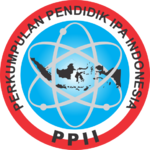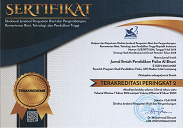Detecting students’ misconception in simple harmonic motion concepts using four-tier diagnostic test instruments
Abstract
Keywords
Full Text:
PDFReferences
Afif, N. F., Nugraha, M. G., & Samsudin, A. (2017). Developing energy and momentum conceptual survey (EMCS) with four-tier diagnostic test items. AIP Conference Proceedings, 1848(May). https://doi.org/10.1063/1.4983966
Aiken, L. R. (1985). Three coefficients for analyzing reliability and validity of ratings. Educational and Psychological Measurement, 45, 131–142. https://doi.org/10.1177/07399863870092005
Bashooir, K., & Supahar, S. (2018). Validitas dan reliabilitas instrumen asesmen kinerja literasi sains pelajaran fisika berbasis STEM. Jurnal Penelitian Dan Evaluasi Pendidikan, 22(2), 219–230. https://doi.org/10.21831/pep.v22i2.19590
Boone, W. J., Staver, J. R., & Yale, M. S. (2014). Rasch analysis in the human sciences. Dordrecht: Springer.
Fariyani, Q., Rusilowati, A., & Sugianto, S. (2017). Four-tier diagnostic test to identify misconceptions in geometrical optics. Unnes Science Education Journal, 6(3), 1724–1729. https://doi.org/10.15294/usej.v6i3.20396
Gurcay, D., & Gulbas, E. (2015). Development of three-tier heat, temperature and internal energy diagnostic test. Research in Science and Technological Education, 33(2), 197–217. https://doi.org/10.1080/02635143.2015.1018154
Gurel, D. K., Eryilmaz, A., & McDermott, L. C. (2015). A review and comparison of diagnostic instruments to identify students’ misconceptions in science. Eurasia Journal of Mathematics, Science and Technology Education, 11(5), 989–1008. https://doi.org/10.12973/eurasia.2015.1369a
Gurel, D. K., Eryilmaz, A., & McDermott, L. C. (2017). Development and application of a four-tier test to assess pre-service physics teachers’ misconceptions about geometrical optics. Research in Science and Technological Education, 35(2), 238–260. https://doi.org/10.1080/02635143.2017.1310094
Hermita, N, Suhandi, A., Syaodih, E., Samsudin, A., Isjoni, Johan, H., … Safitri, D. (2017). Constructing and implementing a four tier test about static electricity to diagnose pre-service elementary school teacher’ misconceptions. Journal of Physics: Conference Series, 895, 1–6. https://doi.org/10.1088/1742-6596/895/1/012167
Hermita, Neni, Suhandi, A., Syaodih, E., Samsudin, A., Isjoni, & Rosa, F. (2017). Assessing pre-service elementary school teachers’ alternative conceptions through a four-tier diagnostic test on magnetism concepts. Advanced Science Letters, 23(11), 10910–10912. https://doi.org/10.1166/asl.2017.10184
Irwansyah, I., Sukarmin, S., & Harjana, H. (2018). Development of three-tier diagnostics instruments on students misconception test in fluid concept. Jurnal Ilmiah Pendidikan Fisika Al-Biruni, 7(2), 207. https://doi.org/10.24042/jipfalbiruni.v7i2.2703
Kamilah, D. S., & Suwarna, I. P. (2016). Pengembangan three-tier test digital untuk mengidentifikasi miskonsepsi pada konsep fluida statis. Edusains, 8(2), 212–220. https://doi.org/10.15408/es.v8i2.5192
Kanli, U. (2015). Using a two-tier test to analyse students’ and teachers’ alternative concepts in astronomy. Science Education International, 26(2), 148–165.
Kirbulut, Z. D., & Geban, O. (2014). Using three-tier diagnostic test to assess students’ misconceptions of states of matter. Eurasia Journal of Mathematics, Science and Technology Education, 10(5), 509–521. https://doi.org/10.12973/eurasia.2014.1128a
Krisdiana, A., Aminah, N. S., & Nurosyid, F. (2018). The use of a four-tier wave diagnostic instrument to measure the scientific literacy among students in SMA negeri 2 Karanganyar. Journal of Physics: Conference Series, 997(1). https://doi.org/10.1088/1742-6596/997/1/012042
Kuczmann, I. (2017). The structure of knowledge and students’ misconceptions in physics. AIP Conference Proceedings, 1916(050001). https://doi.org/10.1063/1.5017454
Lin, S. Y., & Singh, C. (2015). Effect of scaffolding on helping introductory physics students solve quantitative problems involving strong alternative conceptions. Physical Review Special Topics - Physics Education Research, 11(2). https://doi.org/10.1103/PhysRevSTPER.11.020105
Ling, T. W. (2017). Fostering understanding and reducing misconceptions about image formation by a plane mirror using constructivist-based hands-on activities. Overcoming Students’ Misconceptions in Science: Springer Nature Singapore, 203–222. https://doi.org/10.1007/978-981-10-3437-4
Mardapi, D. (2017). pengukuran, penilaian, dan evaluasi pendidikan. Yogyakarta: Parama Publishing.
Nugraha, D. A., Cari, C., Suparmi, A., & Sunarno, W. (2019). Physics students’ answer on simple harmonic motion. Journal of Physics: Conference Series, 1153(1). https://doi.org/10.1088/1742-6596/1153/1/012151
Oriondo, L. L., & Dallo-Antonio, E. M. (1984). Evaluating educational outcomes (test, measurement, and evaluation) (5th editio). Queson City: REX Printing Company, Inc.
Sholihat, F. N., Samsudin, A., & Nugraha, M. G. (2017). Identifikasi miskonsepsi dan penyebab miskonsepsi siswa menggunakan four-tier diagnostic test pada sub-materi fluida dinamik: azas kontinuitas. Jurnal Penelitian & Pengembangan Pendidikan Fisika, 3(2), 175–180. https://doi.org/10.21009/1.03208
Somroob, S., & Wattanakasiwich, P. (2017). Investigating student understanding of simple harmonic motion. Journal of Physics: Conference Series, 901(1). https://doi.org/10.1088/1742-6596/901/1/012123
Subali, B., & Pujiati, S. (2012). Pengembangan item tes konvergen dan divergen dan penyelidikan validitasnya secara empiris. Yogyakarta: Diandra Pustaka Indonesia.
Sugara, Y. D., Sutopo, S., & Latifah, E. (2017). Pemikiran siswa ketika menyelesaikan soal-soal textbook dan real-world. Jurnal Pendidikan: Teori, Penelitian, Dan Pengembangan, 2(11), 1534–1538.
Sugiyono. (2016). Metode penelitian pendidikan (pendekatan kuantitatif, kualitatif, dan R&D). Bandung: Alfabeta.
Sumintono, B., & Widhiarso, W. (2015). Aplikasi pemodelan rasch pada assessment pendidikan. Cimahi: Trim Komunikata Publishing House.
Supahar, S., & Prasetyo, Z. K. (2015). Pengembangan instrumen penilaian kinerja kemampuan inkuiri peserta didik pada mata pelajaran fisika SMA. Jurnal Penelitian dan Evaluasi Pendidikan, 19(1), 96–108. https://doi.org/10.21831/pep.v19i1.4560
Taslidere, E. (2016). Development and use of a three-tier diagnostic test to assess high school students’ misconceptions about the photoelectric effect. Research in Science and Technological Education, 34(2), 164–186. https://doi.org/10.1080/02635143.2015.1124409
Tumanggor, A. M. R., Jumadi, J., Wilujeng, I., & Ringo, E. S. (2019). The profile of students’ physics problem solving ability in optical instruments. Jurnal Penelitian & Pengembangan Pendidikan Fisika, 5(1), 29–40. https://doi.org/10.21009/1.05104
Widiyatmoko, A., & Shimizu, K. (2018). The development of two-tier multiple choice test to assess students’ conceptual understanding about light and optical instruments. Jurnal Pendidikan IPA Indonesia, 7(4), 491–501. https://doi.org/10.15294/jpii.v7i4.16591
Wijaya, C. P., Supriyono Koes, H., & Muhardjito. (2016). The diagnosis of senior high school class X MIA B students misconceptions about hydrostatic pressure concept using three-tier. Jurnal Pendidikan IPA Indonesia, 5(1), 14–21. https://doi.org/10.15294/jpii.v5i1.5784
Wiyono, F. M., Sugiyanto, S., & Yulianti, E. (2016). Identifikasi hasil analisis miskonsepsi gerak menggunakan instrumen diagnostik three tier pada siswa SMP. Jurnal Penelitian Fisika dan Aplikasinya (JPFA), 6(2), 61–69. https://doi.org/10.26740/jpfa.v6n2.p61-69
Yusrizal, & Halim, A. (2017). The effect of the one-tier, two-tier, and three-tier diagnostic test toward the students’ confidence and understanding toward the concepts of atomic nuclear. Unnes Science Education Journal, 6(2), 1593–1600.
Zulfiani, Juanengsih, N., Suwarna, I. P., & Milama, B. (2014). Analysis of students’ misconceptions on basic concepts of natural science through cri (certainly of response index), clinical interview, and concept maps. Proceeding of International Conference On Research, Implementation and Education of Mathematics and Sciences
DOI: http://dx.doi.org/10.24042/jipfalbiruni.v9i1.4571
Refbacks
- There are currently no refbacks.

Jurnal ilmiah pendidikan fisika Al-Biruni is licensed under a Creative Commons Attribution-ShareAlike 4.0 International License.
![]()








